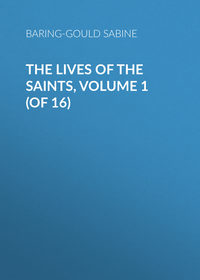 полная версия
полная версияThe Lives of the Saints, Volume III (of 16): March
In the reign of Maximian and Maximin, Agrippa was sent into Pontus, to be governor in the room of Asclepiades, with orders to constrain all Christians to sacrifice. Basiliscus, Eutropius, and Cleonicus, three Christians of Amasea, were seized and thrown into prison. And when Eutropius and Cleonicus had suffered, the blessed Basiliscus with many tears prayed, saying, "O Lord Jesus Christ, remember me, even unto the end, and make my calling manifest unto all, that I may not be separated from these holy men who have been taken with me, and who have suffered before me, and are crowned!" Then the Lord appeared to him and said, "I will not forget thee. Thy name is written with those who have been with thee. But be not downcast because thou art last; for thou shalt precede many. But go, bid farewell to thy mother and thy brethren, and when thou returnest, thou shalt receive thy crown. Fear not the torments prepared for thee, for I shall be at thy side."
Then Basiliscus asked, and prevailed on, the jailor to let him go to the village of Cumiala, near Amasea, where his mother lived, that he might say farewell to her. Now it fell out that early in the morning Agrippa unexpectedly sent for Basiliscus, and when he heard of the indulgence that had been granted him – though soldiers had been sent as guards with the prisoner – he was filled with rage, and threatened the jailor with capital punishment. Then he called to him a city officer named Magistrianus, a brutal fellow, implacable in his detestation of Christianity, and commissioned him to take a band of soldiers and convey Basiliscus to Comana, whither he himself was starting. Magistrianus mounted his ass, and ambled to Cumiala, and surrounded the doors of the house, as Basiliscus was parting with his mother and three brothers, before returning. Magistrianus ordered a pair of boots to be put on Basiliscus, with the nails in them protruding, and then bade him limp along among the guards back to Amasea. The nails made his feet bleed, and as he walked through the street of Amasea a crowd gathered, murmuring against the tyranny of the governor and his satellites. Magistrianus, in a rage, leaped off his ass, and cudgelled the mob with the stick he had used to make the ass go, and the soldiers assisted him to disperse the crowd. Basiliscus was then led along the road to Comana, singing, "Though an host of men be set against me, yet shall not my heart be afraid; for thou, O Christ, art with me!"
At mid-day the party, which consisted of fifteen, came to a little village, and a lady's villa. The lady very courteously invited the officer and his men into the house to refresh themselves, and they tied Basiliscus with his hands behind his back to a plane tree in the court yard. A number of the villagers came up to stare at the martyr, who stood under the dry tree, suffering intensely from the heat, and with blood dribbling from his wounded feet, "whilst Magistrianus and his folk were feasting in Trojana's house, on all kinds of delicacies, meats, and costly wines, served up in the cool summer dining hall," says Eusignius, bitterly.
But God did not forget the poor martyr under the blazing mid-day sun, for the plane tree put forth leaves, and overshadowed him, and a fountain bubbled at his feet, and cooled and laved his festering wounds.
On the party reaching Comana, Magistrianus led Basiliscus direct to the temple of Apollo, where was the governor at the moment.
The governor at once ordered him to be brought in. Basiliscus smilingly entered. "Why wilt thou not sacrifice, fellow?" asked the governor. "Who told thee that I will not sacrifice?" answered Basiliscus. "Ah! the gods be praised! thou wilt sacrifice then."
"I will offer to God the sacrifice of praise." "Offer to whom you please," said the governor, sharply, "only sacrifice and have done with this folly."
"Who is that?" asked Basiliscus, pointing to the image of Apollo. "That is the god Apollo," answered Agrippa. "The name is appropriate enough," said Basiliscus, "for he brings to destruction all who trust in him."6 Then he cried aloud to all in the temple, "Hearken, all men, to my prayer, to the Lord of Heaven and earth." And he prayed, "God, who art alone and true, with thine only-begotten Son, and the Holy Spirit; who art invisible, incomprehensible, whom none can describe and include, who art good and merciful, and acceptest not the person of man, who createst the things that are out of that which is not, and enlightenest us who sat in darkness, and gavest us the bright knowledge of Thy deity: Thou art the helper of all them that trust in Thee. God, who art alone holy, and dwellest in Thy saints, in me, thy humble servant, exhibit Thy mercy, and confirm my prayer, for I pray to Thee of Thy great goodness, Thou who spreadest out the heavens as a curtain, and by Thy command makest them fast, and adornest them with the bright shining stars, and with the glory of the sun, and the moon walking in brightness, and givest us the hours of day; Thou didst make Thy sun a chamber, and gavest him everlasting limits, and didst set the moon to rule the course of time, and didst divide the hours and days and months; Thou didst found the earth by Thy command, that it should be an habitation for man, and didst give to it an everlasting bound, and didst clothe it with trees and flowers; Thou didst lay the sea and bound it by Thy precept, and madest a way over it; and didst fashion man with Thine own holy hands after Thine image, and didst give him wisdom and reason, and didst breathe into his face the breath of life. Lord, who didst create the whole world, who from Adam till this present, and hereafter till endless ages, keepest those that love Thee, and glorifiest those that fear Thee! Lord Jesus Christ! hear the prayer of Thy servant, and be present with me at this hour, and destroy this deaf, and dumb, and blind, and senseless idol; break and dissolve this god made with hands, and shew to these heathen the madness of their worship, and Whom we worship and adore as God. Why do the heathen rage, and the people imagine a vain thing against Thy saints? Look, O Lord, and keep not still silence, for thus behoves all honour and glory and magnificence to Thee, Father, Son, and Holy Ghost, through ages of ages. Amen."
And when he had said Amen, there was an earthquake, and a thunder underground, and the temple shook to its foundations, and the image of Apollo fell and was broken. Then all who were in the temple fled, leaving Basiliscus alone with the broken idol at his feet. And when the earthquake was past, the governor sent, and brought Basiliscus forth, and his head was struck off with the sword. The governor ordered the body to be thrown into the river, but Eusignius bribed the soldier who was carrying it away to let him have it, and he buried it in a field, and sowed herbs over it. S. Basiliscus died on July 21st. He appeared in vision to S. Chrysostom the night before that aged saint died; (see Jan 27th, p. 412.)
S. WINWALOE, AB(6TH CENT.)[Anglican Martyrologies; Saussaye, in his Gallican Martyrology, the Belgian Martyrologies. His translation from the old wooden church at Landevenec, to a stone one, is commemorated on April 28th, and to Montreuil-sur-Mer, on August 1st. Authorities: – Three Lives; the first by an anonymous writer, given by the Bollandists, is full of fable, and by no means early. The second is still less trustworthy, and is given by Surius. The third is by Gurdestin, Monk of Landevenec. The life by Albert le Grand is deserving of notice, but the historical particulars are not accurate. There is great difficulty about this saint. It is probable that there were two of his name, and only by this means can the very different accounts of his life be reconciled. One Winwaloe is a native of Brittany, and a disciple of S. Corentine, and was translated to Montreuil. Another Winwaloe is a native of Britain, a disciple of S. Sampson, of Dol, and afterwards of S. Similian, abbot of Tauriac; and his body lies at Ghent. M. Ch. Barthelemy, in his "Annales Hagiologiques de la France," 5th cent., claims for the first anonymous life to have been written by a disciple of Winwaloe. But this is more than improbable. It has none of the elements of a contemporary account. The writer says that the name of the mother of the saint was not known; and he does not name his master in the religious life, S. Corentine or S. Budock, but calls him "a holy man," or "that man of God"; and the life, like all late compilations, gives scanty details of persons and places, but abounds in fables.7]
Winwaloe was born about the year 455; his father was Fragan, related to Conan Meriadec. Fragan was governor of Léon (Lyoness) and Cornonaille, under King Grallo, or Gradillon. Fragan married a noble and wealthy lady named Gwen, of the Three Breasts, and resided with her at Lesgwen, in the parish of Plonkin. By her he had a son, whom he called Gwenaloe,8 or "He that is white," on account of his beauty. When Winwaloe was about fifteen years old he was given to a holy man, S. Corentine, or S. Budock, it is uncertain which, together with his brothers, Gwethenoc and Jacut, and they lived together, serving God in the islet of Isle-vert.
One day that Winwaloe was with his father, a fleet of pirates appeared off the coast, and hovered about the harbour of Guic Sezne, near Lauvengat. S. Winwaloe is said in the popular tradition to have exclaimed on the occasion, Me a vel mil Guern, "I see a thousand sails;" and a cross which commemorates the spot is called therefrom to this day, Croas al mil Guern, "the cross of the thousand sails." The pirates landed, but Fragan, having gathered his retainers, fell upon them and utterly defeated them. Many were cut to pieces, and a few escaped in their vessels. During the combat, Winwaloe, like a second Moses, prayed with fervour; and after the victory he exhorted his father to employ the spoil they had taken in building a monastery on the spot where the battle took place, in Isel-Vez, in the parish of Plou-Nevez. He did so, and the monastery was called Loc-Christ.
After some years, Winwaloe left his master, and settled in the island of Sein, off the Point du Raz; but, finding it exposed to the full swell of the Atlantic, and to every gale, he was obliged to desert it, and found a more suitable place of settlement at Llandevenec, on the opposite side of the harbour of Brest, where he established a monastery, into which he gathered many disciples, and there, after many years, he died, standing at the altar, after having bestowed the kiss of peace on the brethren, on Saturday, the 3rd of March, in the first week in Lent; a date which may be either 507, 518, or 529.
Another version of the history of S. Winwaloe makes him to have been born in Wales, and to have had S. Budock for his preceptor.
The body of S. Winwaloe is preserved at Montreuil-sur-Mer, whither it was translated through fear of the invasion of the Normans, after having first just found shelter at Ghent. The chasuble, alb and bell of S. Winwaloe, are preserved in the Jesuit Church of S. Charles, at Antwerp.
At the same time, the body of a S. Winwaloe is also at Blandinberg, near Ghent; and the story told of this saint is in many particulars like that of the S. Winwaloe at Montreuil, but it differs in others.
S. Winwaloe is represented in art vested as an abbot, with staff in one hand and bell in the other, standing by the sea, with the fish rising out of the water as if obeying the summons of his bell.
S. KUNEGUND, EMPSS(ABOUT A.D. 1040.)[German, Cologne, Basle, and Roman Martyrologies; also in the Benedictine Martyrology of Wyon. Proper offices in the Brussels, Passau Ratisbon, Salzburg, Frisingen, Bamberg, Eichstadt, Vienna, and other Breviaries. Her translation is celebrated on September 9th; and her canonization on March 29th. At Bamberg she is again commemorated on August 1st. Her life was written after 1190. This life forms the Breviary lessons at Bamberg on March 3rd and August 1st. Other authorities are the historians of the time.]
S. Kunegund, or Cunegundes, was the daughter of Sigfried, count of Luxemburg, and Hedewig, his pious wife. She was married to S. Henry, duke of Bavaria. Her sister was married to Gerard, Count of Alsace. Her brothers were Henry, created, in 103, duke of Bavaria, when S. Henry was emperor; Frederick, count of Luxemburg on the death of his father; Dietrich, bishop of Metz; and others.
On the death of the emperor Otho III., S. Henry was elected king of the Romans, and was crowned at Mentz on June 6th, 1002. Kunegund was crowned empress at Paderborn, on August 10th, in the same year. Immediately on his coronation his cousin, the Margrave, Henry of Schwein-furt, demanded the dukedom of Bavaria, and his own brother, Bruno, made a similar claim. But the emperor refused to give it to either, and bestowed it on Henry, Count of Luxemburg, his wife's brother. The two disappointed competitors then conspired against him with Boleslas II., of Bohemia, but they were defeated by the emperor near Creusen, in 1003, and were pardoned. Adalbert, another brother of Kunegund, then expelled Megingod, archbishop of Treves, and seized on the diocese for himself, but the emperor deposed him, and restored the rightful archbishop.
In 1013, Henry and Kunegund received the imperial crown at Rome, from the pope. It was on this occasion that the pope bestowed on the emperor the golden ball, the emblem of the globe over which he was destined to rule. The imperial pair, it is said, had taken the vow of chastity, but of this there is no evidence. Kunegund's virtue, however, did not escape slander, and she voluntarily underwent the ordeal by fire, and walked unharmed over glowing ploughshares to testify her innocence.
S. Henry founded the bishopric of Bamberg, partly at the instigation of S. Kunegund, who obtained for the city such privileges, that it became a popular saying there, that Kunegund's silk threads defended Bamberg better than walls and towers. Pope Benedict VIII. visited Bamberg in 1020, for the purpose of consecrating the new establishment. Kunegund also built and endowed a Benedictine abbey for nuns, at Kaufungen, near Cassel. Before it was finished, in 1024, S. Henry died. On the anniversary of his death, in 1025, she assembled a great number of prelates to the dedication of her church at Kaufungen; and after the singing of the gospel, she offered on the altar a piece of the true cross, and then put off her imperial robes, and clothed herself with a poor habit; her hair was cut off, and the bishop put on her a veil, and a ring as a pledge of her fidelity to her heavenly Spouse. After she was consecrated to God in religion, she seemed entirely to forget that she had been empress, and behaved as the last in the house, being persuaded that she was so before God. She feared nothing more than whatever could bring to her mind the remembrance of her former dignity. She prayed and read much, worked with her hands, and took a singular pleasure in visiting and comforting the sick. Thus she passed the fifteen last years of her life, never suffering the least preference to be given her above any one in the community. Her mortifications at length reduced her to a very weak[Pg 53][Pg 54] condition, and brought on her last sickness. Her monastery and the whole city of Cassel were grievously afflicted at the thought of their approaching loss; she alone appeared without concern, lying on a coarse hair-cloth, ready to give up the ghost, whilst the prayers of the dying were read by her side. Perceiving they were preparing a cloth fringed with gold to cover her corpse after her death, she ordered it to be taken away; nor could she be at rest till it was promised that she should be buried as a religious in her habit. She died on the 3rd of March, 1040. Her body was carried to Bamberg, and buried near that of her husband. The greatest part of her relics still remains in the same church. She was solemnly canonized by Innocent III. in 1200.
She is represented in art with the ploughshares at her feet.
March 4
S. Lucius, Pope, M. at Rome, A.D. 253.
SS. Nine Hundred Martyrs on the Appian Way, at Rome, circ. A.D. 260.
S. Caius the Palatine, and xxvii. Companions, MM. at Rome.
S. Owen, Mk. at Lastingham, end of 7th cent.
S. Basinus, B. of Treves, circ. A.D. 672.
SS. Adrian, B. of S. Andrews, and Comp., MM. in the Isle ofMay, circ. A.D. 870.
S. Casimir, Prince of Poland, A.D. 1484.
S. LUCIUS, POPE, M(A.D. 253.)[Usuardus, Ado, Notker, Wandelbert, and Roman Martyrologies. Authorities: – Eusebius, the letters of S. Cyprian, Anastasius Bibliothecarius, and a Life by Guaiserius, a monk, (11th cent.)]
Saint Lucius was a Roman by birth, and one of the clergy of that church under SS. Fabian and Cornelius. This latter having been crowned with martyrdom, in 252, S. Lucius succeeded him in the pontificate. The emperor Gallus having renewed the persecution of his predecessor Decius, at least in Rome, this holy pope was no sooner placed in the chair of S. Peter, than he was banished, though to what place is uncertain. "Thus," says S. Dionysius of Alexandria, "did Gallus deprive himself of the succour of heaven, by expelling those who every day prayed to God for his peace and prosperity." S. Cyprian wrote to S. Lucius to congratulate him both on his promotion, and on having had grace to suffer banishment for Christ. Our saint had been but a short time in exile when he was recalled, to the great joy of his people, who went out of Rome in crowds to meet him. S. Cyprian wrote to him a second letter of congratulation on this occasion. He says, "He had not lost the dignity of martyrdom because he had the will, as the three children in the furnace, though preserved by God from death; this glory added a new dignity to his priesthood; so that he, a bishop, assisted at God's altar, who could exhort his flock to martyrdom by his own example as well as by his words. By giving such graces to his pastors, God showed where his true Church was: for he denied the like glory of suffering to the Novatian heretics. The enemy of Christ only attacks the soldiers of Christ: heretics he knows to be already his own, and passes them by. We supplicate God the Father and His Son, our Lord, giving thanks and praying together, that He who perfects all may bring you to the glorious crown of your confession, who, perhaps, has only recalled you that your glory might not be hidden; for the victim who owes his brethren an example of virtue and faith, ought to be sacrificed before their eyes."
Eusebius says that Lucius did not occupy the pontifical throne for above eight months. He seems to have died on March 4th, under Gallus, but how we know not. His body was found in the Catacombs, and was laid in the church of S. Cecilia at Rome, where it is now exposed to the veneration of the faithful. Considerable portions of the body of S. Lucius, M., are preserved at Bologna, and a head, purporting to be that of S. Lucius, was anciently one of the great relics of Roeskilde Cathedral. But these must be the remains of other saints of the same name, and it was an error of the clergy of Bologna and of Roeskilde to assert that these relics belonged to the martyred pope. That such a mistake may easily have been made is seen from the fact that two martyrs of the name of Lucius are commemorated on this day, the second being a companion of Caius the Palatine; and six in January, and as many in February, not to mention those in the other months. In the Schleswig Breviary, published in 1512, the feast of S. Lucius, Pope, M., was observed on account of the presence of the head of a S. Lucius, M., at Roeskilde, with nine lessons at matins, of which the six first were taken from the account of the Life and Translation of S. Lucius the pope, made by pope Paschal in 812.
S. CAIUS THE PALATINE, AND COMP., MM(DATE UNCERTAIN.)[Bede, Usuardus, Ado, Notker, Roman Martyrology. The names of the companions of S. Caius vary in the Martyrologies.]
S. Caius, and twenty-seven fellow soldiers, suffered for the faith at Rome. Caius was an officer of the palace, but under what emperor is not known. He was drowned in the sea.
S. OWEN, MK(END OF 7TH CENT.)[Anglican and Benedictine Martyrologies. Authority: – Bede, Hist. Eccl., lib. iv. c. 3.]
The venerable Bede says, "Owen was a monk of great merit, having forsaken the world with the pure intention of obtaining the heavenly reward; worthy in all respects to have the secrets of our Lord revealed to him, and worthy to have credit given by his hearers to what he said; for he came with Queen Etheldreda from the province of the East Angles, and was her prime minister, and governor of her household. As the fervour of his faith increased, resolving to renounce the world, he did not go about it slothfully, but quitting all he had, clad in a plain garment, and carrying an axe and hatchet in his hand, came to the monastery of S. Chad, at Lastingham: denoting that he did not go to the monastery to live idly, as some do, but to labour, and this he confirmed by his practice; for as he was less capable of meditating on the Holy Scriptures, he the more earnestly applied himself to the labour of his hands. In short, he was received by the bishop into the house aforesaid, and there entertained with the brethren, and whilst they were engaged within in reading, he was without doing such things as were necessary.
"One day, when he was thus employed abroad, and his companions were gone to the church, the bishop was alone, reading or praying in the oratory of that place, when, on a sudden, as he afterwards said, he heard voices singing most sweetly, and rejoicing, and appearing to descend from heaven. And this sound seemed to come from the south-east, and it afterwards drew nigh him to the oratory, where the bishop then was, and entering therein, filled the same and all around. He listened attentively to what he heard, and after about half an hour noticed the same strain of joy ascend from the roof of the oratory, and return to heaven the same way it came, with inexpressible sweetness. When he had stood some time wondering, the bishop opened the window of the oratory, and, making a noise with his hand, ordered him to come in to him.
"Then the holy Chad told him that the day of his death was at hand, and that the angelic spirits had told him that in seven days they would return and take him with them. And so it was: seven days after, S. Chad entered into his rest." Nothing more is known of Owen. A stone cross put up by Owen remains at Ely, and is preserved in that cathedral.
S. BASINUS, B. OF TREVES(ABOUT A.D. 672.)[Treves and Cologne Martyrologies; Molanus and Greven. Authority: – His Life by Nizo, Abbot of Metloch (Mediolanum) on the Saar, 11th cent., which is very untrustworthy.]
Basinus, of the illustrious family of the Dukes of Austrasia, was received as monk into the monastery of S. Maximin, at Treves. He was afterwards made abbot, and later, when S. Numerian, bishop of Treves, was dead, he was constrained to assume the mitre in his room. He held the see in the reign of Childebert II., king of Austrasia. He was a friend of S. Willibrord. After his death, his body was laid in the basilica of S. Maximin, under the high altar. It was taken up in 1621, and placed in a more conspicuous position.
He was succeeded by his nephew, S. Lutwin.
S. ADRIAN, M. B. OF S. ANDREWS(ABOUT A.D. 870.)[Aberdeen Breviary. Authority: – The Lections from the same.]
S. Adrian, bishop of S. Andrews, in Scotland, was a native of Pannonia. He laboured to spread the faith among the Picts, together with his companions, Clodian, Caius, Monan, and Stobrand. As they were in the island of May, the Danish pirates landed in it, and put Adrian and Clodian to death.
S. CASIMIR, PRINCE OF POLAND(A.D. 1484.)[Roman Martyrology. Authorities: – Zacharias Ferrier, Papal Legate in Poland, A.D. 1525.]
S. Casimir was the second son of Casimir III., king of Poland, and of Elizabeth of Austria, daughter to the emperor Albert II., a most virtuous woman, who died in 1505. He was born in 1458, on the 5th of October. From his childhood he was remarkably pious and devout. His preceptor was John Dugloss, called Longinus, canon of Cracow, a man of extraordinary learning and piety, who constantly refused all bishoprics, and other dignities of the Church and state which were pressed upon him. Vladislas, the eldest son, was elected king of Bohemia in 1471, and became king of Hungary in 1490. Casimir was the second son; John Albert, the third son, succeeded his father in the kingdom of Poland in 1492; and Alexander, the fourth son, was called to the same in 1501. Casimir and the other princes were warmly attached to the holy man who was their preceptor; but Casimir profited most by his pious maxims and example. He consecrated the flower of his age to the exercises of devotion and penance; his clothes were plain, and under them he wore a hair shirt. He often slept upon the ground, and spent a considerable part of the night in prayer and meditation, chiefly on the passion of our Saviour. He was wont at times to go out in the night to pray before the church-doors, and in the morning waited before them till they were opened for matins. He was especially devout to the passion of our blessed Saviour, the very thought of which excited him to tears. He was no less piously affected towards the Sacrifice of the altar, at which he always assisted with such reverence and attention that he seemed in raptures. And as a mark of his singular devotion to the Blessed Virgin, he composed, or, at least, frequently recited, the long hymn that bears his name, a copy of which was, by his desire, buried with him. His love for Jesus Christ showed itself in his regard for the poor, who are His members, to whose relief he applied whatever he had, and employed his credit with his father, and his brother, Vladislas, king of Bohemia, to procure them succour.









